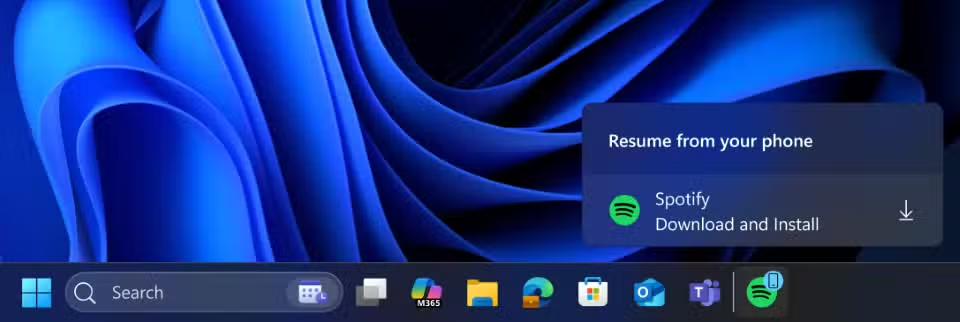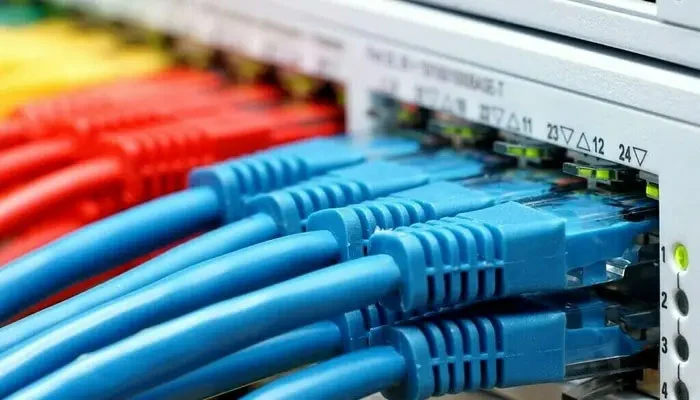Microsoft is testing a major upgrade for its operating system: Windows 11 will let you resume Android apps on Windows. The feature, now rolling out to Windows Insiders, allows users to continue Android app activity directly on their PC. At launch, the functionality is available only for Spotify, but Microsoft plans to expand it to more apps in the future.
How the Feature Works
The feature brings app continuity between phone and PC. If a user starts listening to a song on Spotify’s mobile app, Windows 11 shows a “Resume from your phone” notification on the desktop. The notification appears with Spotify’s icon and a “Continue on this PC” button.
When clicked, Windows 11 either opens Spotify’s desktop app or, if it is not installed, prompts the user to download it. Playback continues seamlessly, creating a fluid experience between mobile and computer.
This handoff-style capability works via Microsoft’s Phone Link integration. To use it, users must connect their Android phone to their PC. Once the connection is active, Windows tracks supported app activity and delivers relevant handoff prompts in the notification center.
Similarities to Apple’s Handoff
The new feature strongly resembles Apple’s Handoff on macOS and iOS. Apple’s system lets users continue tasks such as browsing, email writing, or app usage across iPhone, iPad, and Mac. Microsoft’s first attempt is narrower, focusing only on Spotify. Still, it signals a move toward deeper cross-device synchronization.
Unlike Apple’s ecosystem, which supports a wide range of apps and services, Microsoft’s initial rollout is cautious. For now, there is no support for resuming emails, web browsing, or document editing. However, industry experts believe Microsoft will eventually expand this capability. Future updates could allow users to resume reading, writing, or even gaming across devices.

Why This Matters
The ability to resume Android apps on Windows 11 eliminates one of the biggest disruptions in multitasking. Users often start a task on mobile but later switch to their PC. Without continuity, they must restart the app. With this feature, transitions feel natural and save valuable time.
For professionals, it could mean starting a draft email on the phone and finishing it on the PC without losing context. It could mean reading articles across devices smoothly. For entertainment, it already delivers seamless music playback.
This step aligns with Microsoft’s broader strategy to connect phones and PCs more deeply, closing the gap between desktop and mobile experiences.
Rollout and Availability
Currently, the feature is available to Windows Insiders in the Dev and Beta Channels. Testing begins with Spotify because it is widely used and demonstrates a simple, clear handoff scenario. Users can expect gradual improvements as Microsoft fine-tunes the system.
The feature was originally spotted in a Build 2025 demo, which Microsoft later deleted. Its reappearance confirms that the company plans to make it a cornerstone of Windows 11’s ecosystem integration.
Potential for Expansion
While Microsoft has not revealed which apps will be added next, speculation points to messaging, browsing, and productivity tools. Imagine resuming a WhatsApp chat on your desktop, continuing an article you started on Chrome mobile, or editing a Word document that was opened on your phone.
Such expansion would make Windows 11 a true competitor to Apple’s ecosystem. It would also appeal strongly to Android users, who form the majority of the global smartphone market.
Security and Privacy
As with all continuity features, security is critical. Microsoft assures users that activity transfers occur through encrypted channels. This ensures that sensitive information, such as private conversations or login details, remains secure during the handoff. Additionally, users will have full control to enable or disable the feature.
A Step Toward a Unified Ecosystem
Microsoft’s push to let Windows 11 resume Android apps on Windows is part of a larger effort to create a unified, cross-device ecosystem. With hybrid work becoming the norm, people switch between phones and PCs constantly. By offering seamless transitions, Microsoft improves productivity and user satisfaction.
Industry analysts believe this could increase adoption of Windows 11. Many who have delayed upgrading may now see stronger reasons to move away from Windows 10. Businesses, too, may explore new workflows based on app continuity.
Final Thoughts
The arrival of app continuity marks a significant milestone for Microsoft. While the feature is limited to Spotify at the moment, it sets the stage for broader integration. By enabling Windows 11 users to resume Android apps on Windows, Microsoft is closing the gap between mobile and desktop worlds.
As the rollout expands, users can expect more supported apps and smoother transitions. This feature could redefine how people interact with their devices, offering flexibility, efficiency, and a stronger sense of ecosystem unity.
For now, Windows Insiders get the first glimpse of this exciting upgrade. In the coming months, it could become one of the most impactful features of Windows 11—shaping the future of cross-device computing.
ALSO READ: WhatsApp beta adds voice messages for missed calls





